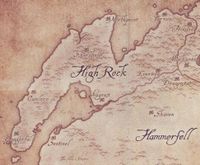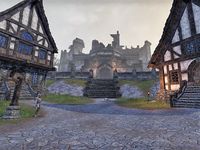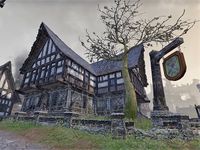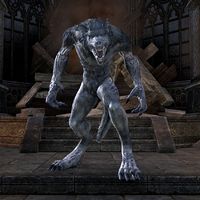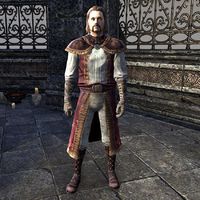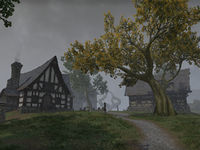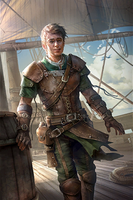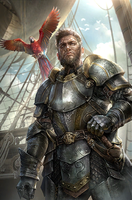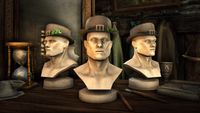Lore:Camlorn
| Camlorn | |
|---|---|
| Type | Settlement |
| Continent | Tamriel |
| Province | High Rock |
| Region | Glenumbra (Cambray Hills) |
| Appears in | Arena, ESO |
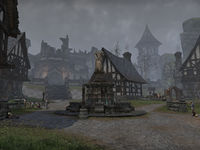
|
Camlorn (sometimes called Camlarn)[1] is one of the nine historical Breton kingdoms in the province of High Rock,[2][3] situated on the coastal highlands of Glenumbra. Camlorn and the surrounding region is a melting pot of several different Breton cultures[4] and its people fancy themselves as more refined and metropolitan compared to their neighbors in Daggerfall.[5] The kingdom's nobility consider themselves an aristocracy of poets and artisans. It has also greatly benefitted from trade coming from either the Eltheric Ocean or the Iliac Bay.[4] As of 3E 432, Camlorn was one of five major kingdoms in High Rock.[6]
Contents
Layout and Geography[edit]
Camlorn is a large, walled-off city located in the middle of the Cambray Hills and west of the Skeffington Wood.[1] It is specifically built on the epicenter of the region and most roads in the area all lead to the city's outskirts and the Cambray Pass. The city itself is placed on a tall hill that is scaleable only from the south. The city's outskirts are largely rocky and have few open plots of land, as it all descends north into the coast. There is at least one farm outside of the city, next to the sewer entrance.[7] Like other kingdoms, Camlorn has a series of vassal principalities and duchies under its command, as well as smaller settlements between them.[8] Among these include the Duchy of Oloine and the village to the east, Umbington.[9]
Camlorn's city gate has a courtyard that connects to three different districts of Camlorn, the western area that continues north to the Temple of the Divines, the central area that leads to Camlorn Keep, and a third smaller area with several homes. Throughout the city are a series of watchtowers.[7] The city's main street is wide and anchored by the Temple of Sethiete and the Camlorn Royal Palace,[8] but before it reaches the palace, it meets the western district at a town square, surrounded by a watering well.[7] The city has a northern quarter that is very affluent and contains the local Prostitutes Guildhouse, a grand palace.[10] The north end of the city also has the Camlorn Royal Palace, the seat of power in both the capital city and the kingdom. There is a path behind the castle that goes outside the walls and onto a cliffside that overlooks the Eltheric Ocean[7] and a wide, rocky promontory called Cavilstyr Rock.[8] Camlorn is neighbored by several settlements, including Ebon Wastes to the south and Moonguard to the east.[3]
Notable Locales[edit]
|
|
History[edit]
Early History[edit]
Camlorn was founded by the Nords during the Nordic Empire's occupation of High Rock in the early First Era. It started as a Nordic city but as their influence started to wane and the Breton population increased, Camlorn was fully assimilated by the locals.[6] One of the city's first rulers was a figure known as the Iron Son, who wielded a powerful sword made from Black-Iron and created a powerful dynasty.[12] Interestingly, maps of the Direnni Hegemony circa 1E 484 had a myriad of discrepancies, among which include Camlorn's omission when compared to other maps. A member of the Antiquarian Circle, Verita Numida believed it was a deliberate choice from the Direnni to mask their shrinking territories.[13]
Sometime around 2E 70, the Duke of Camlorn's daughter was kidnapped by a group of bandits who demanded a large ransom of money. One knight stepped forward and rescued her, the knight, Justin Dufort. As a reward, Sir Justin earned the Duke's favor and a small amount of gold, but in the long term, his family name had increased influence and turned into a prosperous merchant family. Since then, House Dufort became one of two families to dominate the Duchy of the Systres.[14] Camlorn acquired its status as a kingdom sometime in 2E 301 and every year held a grand celebration in the capital city.[8]
In 2E 478, the Gardners of Wayrest had troubles with an "Ascendant Camlorn" and was entirely occupied with the situation. So much so that they ignored the coup that rose in the Systres, when House Mornard seized one-third of Dufort's land and exiled their leadership to Amenos.[15] It later took part in the Battle of Granden Tor[16] and sometime later, in the province's dozen years of peace, Camlorn became an independent city-state by 2E 541.[17]
Camlorn in the Daggerfall Covenant[edit]
The city was ransacked during Emperor Durcorach's invasion of High Rock in 2E 541, after his failed siege against Wayrest. When the Reach was defeated a year later at Daggerfall's gates, Camlorn and its monarch gathered with other Breton kingdoms to form the First Daggerfall Covenant under the newly named High King of Wayrest, Emeric of Cumberland.[17] The Kings of the Covenant were invited to Emeric's wedding in the spring of 2E 566[18] and were later drawn to Ranser's War, a civil conflict against the Kingdom of Rivenspire and their allies. The war later gave rise to the Greater Daggerfall Covenant, which now incorporated the Redguards of Hammerfell and the Orcs of Wrothgar.[19]
During the Interregnum in 2E 582, the Bloodthorn Cult invaded Glenumbra and after a failed attempt at sabotage in the Beldama Wyrd Tree, they made their way north toward Camlorn and worked with the resurrected Faolchu. The undead werewolf made contact with a local named Jonathan Telwin and inflicted him with lycanthropy. With this condition, Jonathan traveled to Camlorn and spread it among the populous in the middle of the night. People mistook the howls for wild dogs but it became a lot clear that the city was infested with a pack of bloodthirsty werewolves.[20]
The Captain of the City Guard, Darien Gautier led a defense against the attack and managed a holdout in the city's inn with survivors. Camlorn was taken over by Faolchu and his pack[20] while the royal family was forced to flee with refugees to nearby Aldcroft.[21] In time, the Lion Guard prepared to retaliate[22] and built their siege camp south of the city's gate but when Faolchu's forces took it over, it split the army in half by each side of the camp. General Gautier enlisted the help of an Agent of the Covenant and managed to reunite with General Mendin's forces while retaking the camp. With one more push into the gate's courtyard, the Lion Guard had entered the city.[23]
General Gautier sent the Agent to locate his son, Darien and help him in the relief effort. They found him in the inn in Camlorn's western district and with the help of a local alchemist, Alinon, they managed to cure citizens of lycanthropy and round up weapons for the city's defense.[24][25] The invading force had greatly dwindled and all that was left was Faolchu, who was held up in the ruined Camlorn Keep. In a final battle, the werewolf general was defeated and Camlorn was liberated.[26] As their plans fell apart, the Bloodthorn Cult took hold in Cath Bedraud while the Lion Guard prepared for a final attack in King's Guard.
Camlorn in the Third Empire[edit]
The historical-fiction series, the Wolf Queen recounts how Emperor Pelagius Septim II and his wife, Quintilla met. In the autumntide of 3E 63, the widowed Prince Pelagius II and his son, Antiochus traveled to Camlorn to pay court to King Vulstaed's daughter, Princess Quintilla, well-renowned at the time as a beauteous princess, accomplished as well as a maiden and sorceress. Pelagius II arrived at the city-state to find it terrorized by a great demon werewolf and together with the princess, defeated the monster and bound it into a yellow soul gem. The prince then fashioned the gem into a ring and proposed to the princess. Legend has it though that the soul of the wolf stayed with them until the birth of their first child, Potema. They later went on to have two more children, the brothers Cephorus I and Magnus.[27] The book also attributes the soul gem as the source Pelagius III's infamous madness, making it one of the several possible theories.[28]
During the Imperial Simulacrum in the late Third Era, the city-state of Camlorn was an active settlement. It was ruled by King Edward and had a rivalry with Daggerfall.[29] After acquiring the fifth piece of the Staff of Chaos, the Eternal Champion made their way north into High Rock to seek out the Crypt of Hearts and eventually stumbled into Camlorn where they met Senior-Brother Halfas Varn of the Brotherhood of Seth. The cult had acquired an ancient map with a code that could decipher the dungeon's location on an Elder Scroll but it was stolen by Brother Barnabas of Tethis, who in turn stowed away to the Mines of Khuras. The Eternal Champion delved deep into the dungeon and returned to Halfas Varn with the map intact. The mage-priest was able to locate the Crypt of Hearts and sent the Eternal Champion on their way to the dungeon.[30] After the champion's monumental victory over Jagar Tharn, Imperial-loyalists would retrace the champion's steps throughout their journey across the Empire, stopping in Camlorn.[31]
Following the Warp in the West in 3E 417, in the twilight years of the Third Era, the kingdoms of High Rock favored diplomatic solutions to their problems rather than violence. Despite that, local skirmishes continued on the regular between neighboring nations like between Camlorn, Evermore and Northpoint. By 3E 432, the Kingdom of Camlorn recently celebrated the marriage between Duke Senhyn's daughter, Lady Kelmena, and the Prince of Daggerfall, Camaron. Their union suggested a possible unified kingdom along the province's western coast, in conjunction with Daggerfall's already established relationship with its former rivals, the Kingdom of Sentinel. By the end of the Third Era, Camlorn was one of five kingdoms in High Rock.[6]
Known Rulers[edit]
- Unknown Period
- The Iron Son[12]
- The Second Era
- The Third Era
Culture and Society[edit]
Camlorn's capital by the late Third Era acquired the epithet, the Jewel of the West[29] and although the city stands above sea level, it is well connected to the surrounding waters by two villages; Aldcroft for the Iliac Bay and Eagle's Brook for the Eltheric Ocean.[5] Camlorn is described as a melting pot of various Breton cultures and its nobles fancy themselves as artisans and poets.[4] By the mid-Second Era, Camlorn had rivaled Daggerfall's size and cultural influence and as the writer, Ansur Belote describes, "the citizens of Camlorn see themselves as more urbane and metropolitan then their neighbors to the south".[5]
Camlorn is the home of some prestigious Breton families. One of the most powerful was House Dufort, one of two major proprietors of the Duchy of Systres and later their ruling house in amidst the Three Banners War of the mid-Second Era. It was their ancestor, Justin Dufort, who elevated the family house into a prominent clan of shipwrights and merchants.[14] Another is the Gautier family, who previously owned a family mausoleum up north called the Ebon Crypt.[33] One of their most famous members, Darien Gautier helped liberate the city from werewolves and later partook in the Fighters Guild's invasion of Coldharbour.[34]
Camlorn holds an annual celebration that honors the time their nation was first recognized as a kingdom. Every street from boulevards to alleyways is adorned with gold and purple banners, some marked by the kingdom's heraldic symbols as well as the sigils of Camlorn's vassal principalities and duchies. The streets and plazas are filled to the brim with musicians and entertainers such as Redguard snake charmers, Khajiiti acrobats, and mages performing spectacular illusions. It commonly starts with the March of Beauty, where thousands of young, comely dressed women dance through the city's main street from the Temple of Sethiete to the Camlorn Royal Palace. Dancers mainly came from the local Prostitutes Guild. The celebration ends with the Festival of Flowers, where a large circle surrounded by lit candles is formed on Cavilstyr Rock and dancers flock around with vines and flowers.[8]
The Bretons of Camlorn celebrate Flower Day (observed on the 25th of First Seed) with a large array of beautiful colors and lively entertainment. No other city boasts such a celebration than Camlorn.[35] The holiday across High Rock is meant to celebrate the arrival of spring and as the children pick newly blossomed spring flowers, the old come out of their homes and dance in celebration.[36] The folks of Camlorn also make seasonal tophats for the springtide, usually adorned with a buckle, a lucky bouquet, or shamrocks.[37][38][39]
There is a book written by Mera Llykith called the Mystery of Talara, a fictional book starring the titular character and their quest to learn about their lost identity and the scandal that could threaten the balance of both Camlorn and the Empire. The book takes place in 3E 405 and involves real, historical people such as the Imperial Ambassador of Wayrest, Naigon Strale and the Blades agent, Brisienna Magnessen. It also covers Jagar Tharn's time in the Temple of Sethiete and how he learned about powerful and forgotten spells, as well as the lore behind the Staff of Chaos.[40]
Gallery[edit]
-
Camlorn Adventurer (Legends)
Notes[edit]
- Arena was originally conceived as a fighting game featuring a tournament that took the player to each of Tamriel's cities to challenge different gladiatorial teams. According to a file from that stage of development left behind in the final game, Camlorn's gladiatorial team would have been called "the Dragons".[UOL 1]
See Also[edit]
- For game-specific information, see the Arena and Elder Scrolls Online articles.
Books[edit]
- Glenumbra's Towns and Cities by Ansur Belote — A description of the various settlements in Glenumbra
- Mystery of Talara by Mera Llykith — The five-part story of Princess Talara
References[edit]
- ^ a b Map of West Tamriel – The Elder Scrolls Adventures: Redguard
- ^ Etiquette With Rulers — Erystera Ligen
- ^ a b Map of High Rock – The Elder Scrolls: Arena
- ^ a b c Glenumbra's People — Aldous Brousseau
- ^ a b c Glenumbra's Towns and Cities — Ansur Belote
- ^ a b c d Pocket Guide to the Empire, 3rd Edition: The Sons and Daughter of the Direnni West: High Rock — Imperial Geographical Society, 3E 432
- ^ a b c d e Map of Glenumbra – The Elder Scrolls Online
- ^ a b c d e f g Mystery of Talara, v 1 — Mera Llykith
- ^ Mystery of Talara, v 3 — Mera Llykith
- ^ a b c Mystery of Talara, v 4 — Mera Llykith
- ^ Sewer entrance southwest of Gaudet Farm in ESO
- ^ a b Knight of the Iron Son's dialogue in ESO
- ^ Antique Map of Glenumbra antiquity codex entries in ESO: Greymoor
- ^ a b c History of House Dufort — Kaera Metrick, House Historian and Chronicler
- ^ Systres History: Volume 7 — Trilam Heladren, Associate Dean of Eltheric History, University of Gwylim
- ^ Flayed Flag of Camlorn contraband in ESO
- ^ a b c Triumphs of a Monarch, Ch. 3 — His Majesty King Emeric
- ^ Triumphs of a Monarch, Ch. 6 — His Majesty King Emeric
- ^ The Fury of King Ranser — Wafimeles Masteret (Lorekeeper)
- ^ a b A Plea for Vengeance
- ^ Chamberlain Weller's dialogue in ESO
- ^ General Gautier's dialogue in ESO
- ^ Rally Cry story quest in ESO
- ^ A Lingering Hope story quest in ESO
- ^ Hidden in Flames story quest in ESO
- ^ The Fall of Faolchu story quest in ESO
- ^ a b The Wolf Queen, v1 — Waughin Jarth
- ^ The Wolf Queen, v8 — Waughin Jarth
- ^ a b c Camlorn location and rumors in Arena
- ^ Crypt of Hearts story quest in Arena
- ^ A Minor Maze
- ^ Lineage of Tooth and Claw story quest in ESO
- ^ Ebon Crypt loading screen text in ESO
- ^ Darien Gautier in ESO
- ^ Travels in High Rock
- ^ Flower Day holiday description in Daggerfall
- ^ Camlorn "Lucky Bouquet" Top Hat description text in ESO
- ^ Camlorn Top Hat with Buckle description text in ESO
- ^ Camlorn Top Hat with Shamrock description text in ESO
- ^ Mystery of Talara — Mera Llykith
Note: The following references are considered to be unofficial sources. They are included to round off this article and may not be authoritative or conclusive.
|
|||||
